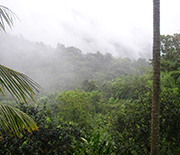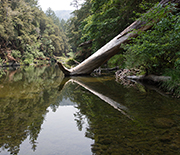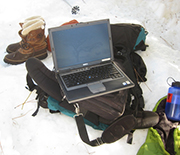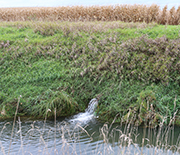News Release 17-111
NSF-supported scientists present research results on Earth's critical zone at 2017 AGU fall meeting
Topics include Puerto Rico's Luquillo Critical Zone Observatory, wildfire in the critical zone, plants as plumbers and builders of the critical zone
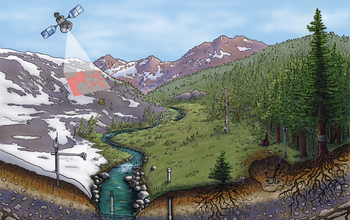
Scientists at NSF's CZOs will present new results at the 2017 AGU meeting.
November 16, 2017
This material is available primarily for archival purposes. Telephone numbers or other contact information may be out of date; please see current contact information at media contacts.
Find related stories on NSF's Critical Zone Observatories at this link.
The thin veneer of Earth's surface that stretches from the top of the forest canopy to the base of bedrock is known as the "critical zone." It's where fresh water flows, rock turns to soil and life flourishes.
To provide a deeper understanding of the critical zone, the National Science Foundation (NSF) supports nine Critical Zone Observatories (CZOs) that stretch from coast to coast. NSF CZO scientists study how the critical zone responds to changes in climate and land use.
At the 2017 AGU Fall Meeting, held at the New Orleans Ernest N. Morial Convention Center in New Orleans, Louisiana, from Dec. 11-15, 2017, dozens of CZO researchers will present new results on a range of topics, from the structure, function and evolution of Earth's "living skin" to the interactions between climate and rocks.
CZO scientists will discuss plants as plumbers and builders of the critical zone; the effects of Hurricane Maria on the Luquillo, Puerto Rico, critical zone; wildfire in the critical zone; rainfall-triggered landslide hazards; carbon dioxide in sagebrush steppe ecosystems; land-use legacies of old-field succession; snow-dominated headwater catchments; and myriad other subjects.
Researchers at NSF's CZOs are working to answer such questions as:
- How do landscapes evolve over human timescales and over millennia, and how is that process affected by the presence and flow of water?
- How do soil and weathered bedrock move down hillslopes, and how are they linked with the evolution of channels that often surround the bases of these hillslopes?
- How do biological processes affect physical processes such as erosion and weathering?
- Are there signals in the landscape that can tell us about past climates and about how landscapes responded then, or might respond in the future, to climate change?
The NSF CZO program will host booth #2032 in the exhibit hall. On Thursday, Dec. 14, the program will host a town hall meeting, "Critical Zone Observatories: Platforms for Collaborative Science," from 12:30-13:30 in the New Orleans Ernest N. Morial Convention Center, rooms 208-209.
Find a partial list of CZO science-related sessions, talks and posters by date/time below.
Monday, Dec. 11, 2017
U13B-37: The influence of critical zone structure on runoff paths, seasonal water storage, and ecosystem composition
15:28 - 15:31 -- New Orleans Ernest N. Morial Convention Center, rooms 252-254
H14D-02: Using a spatially-distributed hydrologic biogeochemistry model with nitrogen transport to study the spatial variation of carbon stocks and fluxes in a Critical Zone Observatory
16:15 - 16:30 -- New Orleans Ernest N. Morial Convention Center, rooms 283-285
H14D-03: Ecohydrological consequences of vegetation interactions within the critical zone in the tropical Andes: multi-scale assessment of vegetation change consequences
16:30 - 16:45 -- New Orleans Ernest N. Morial Convention Center, rooms 283-285
H14D-08: Where should the upper boundary of the earth's critical zone be?
17:45 - 18:00 -- New Orleans Ernest N. Morial Convention Center, rooms 283-285
Tuesday, Dec. 12, 2017
EP21H-01: Lithologic controls on critical zone processes in a variably metamorphosed shale-hosted watershed
08:00 - 08:15 -- New Orleans Ernest N. Morial Convention Center, room 352
B21D-1981: Fostering collaboration across the U.S. Critical Zone Observatories Network
08:00 - 12:20 -- New Orleans Ernest N. Morial Convention Center, Poster Hall D-F
H21A-1439: Critical zone structure inferred from multiscale near surface geophysical and hydrological data across hillslopes at the Eel River CZO
08:00 - 12:20 -- New Orleans Ernest N. Morial Convention Center, Poster Hall D-F
B21J-02: Differential chemical fractionation of dissolved organic matter during sorption by Fe mineral phases in a tropical soil from the Luquillo Critical Zone Observatory
08:15 - 08:30 -- New Orleans Ernest N. Morial Convention Center, rooms 386-387
H22A-01: Boron isotopes at the catchment scale, a new potential tool to infer critical zone processes.
10:20 - 10:35 -- New Orleans Ernest N. Morial Convention Center, rooms 298-299
H22A-02: Decoupling of stream and vegetation solutes during the late stages of weathering: insights from elemental and magnesium isotope trends at the Luquillo Critical Zone Observatory, Puerto Rico
10:35 - 10:50 -- New Orleans Ernest N. Morial Convention Center, rooms 298-299
ED22A-02: Climate change literacy across the Critical Zone Observatory Network
10:35 - 10:50 -- New Orleans Ernest N. Morial Convention Center, room 245
B23D-2097: The potential for iron reduction in upland soils in Calhoun Critical Zone Observatory
13:40 - 18:00 -- New Orleans Ernest N. Morial Convention Center, Poster Hall D-F
EP23C-1938: Subsurface particle loss during shale weathering can alter soil and rock chemistry
13:40 - 18:00 -- New Orleans Ernest N. Morial Convention Center, Poster Hall D-F
H23H: Plants as builders and plumbers of the critical zone I Posters
13:40 - 18:00 -- New Orleans Ernest N. Morial Convention Center, Poster Hall D-F
- H23H-1768: Soil weathering agents are limited where deep tree roots are removed, even after decades of forest regeneration
- H23H-1769: Predicting Plant-Accessible Water in the Critical Zone: Mountain Ecosystems in a Mediterranean Climate
- H23H-1771: Illuminating pathways of forest nutrient provision: relative release from soil mineral and organic pools
- H23H-1777: How soil water storage moderates climate changes effects on transpiration, across the different climates of the Critical Zone Observatories
- H23H-1779: Temporal dynamics of tree source water in sky island ecosystems with ephemeral snow pack: a case study using Pseudotsuga menziesii (Douglas Fir)
- H23H-1780: The Dual Role of Vegetation as a Constraint on Mass and Energy Flux into the Critical Zone and as an Emergent Property of Geophysical Critical Zone Structure
- H23H-1781: Gilbert's soil production paradigm applied to a critical zone's fractionation of particle sizes
B23C-2076: Coupled modeling of rhizosphere and reactive transport processes
13:40 - 18:00 -- New Orleans Ernest N. Morial Convention Center, Poster Hall D-F
H23N-08: Wildfire in the critical zone: pyro-geomorphic feedbacks in upland forests
15:21 - 15:38 -- New Orleans Ernest N. Morial Convention Center, rooms 283-285
ED24A-02: Teaching climate science within the transdisciplinary framework of critical zone science
16:20 - 16:35 -- New Orleans Ernest N. Morial Convention Center, room 245
Wednesday, Dec. 13, 2017
B31H-01: Using the Critical Zone Observatory Network to put geology into environmental science
08:00 - 08:05 -- New Orleans Ernest N. Morial Convention Center, rooms 383-385
H31J-08: An integrated geophysical and geochemical exploration of critical zone weathering on opposing montane hillslope
09:45 - 10:00 -- New Orleans Ernest N. Morial Convention Center, rooms 298-299
B33D-2108: Portable gamma spectrometry: measuring soil erosion in-situ at four Critical Zone Observatories in P. R. China
13:40 - 18:00 -- New Orleans Ernest N. Morial Convention Center, Poster Hall D-F
H33A-1645: Quantifying seasonal dynamic water storage in a fractured bedrock vadose zone with borehole nuclear magnetic resonance
13:40 - 18:00 -- New Orleans Ernest N. Morial Convention Center, Poster Hall D-F
H33D-1709: Imaging preferential flow pathways of contaminants from passive acid mine drainage mitigation sites using electrical resistivity
13:40 - 18:00 -- New Orleans Ernest N. Morial Convention Center, Poster Hall D-F
B33G-03: Deep soil carbon in the critical zone: amount and nature of carbon in weathered bedrock, and its implication for soil carbon inventory
14:10 - 14:25 -- New Orleans Ernest N. Morial Convention Center, rooms 386-387
Thursday, Dec. 14, 2017
B41E-2011: Toward a standardized soil carbon database platform in the U.S. Critical Zone Observatory Network
08:00 - 12:20 -- New Orleans Ernest N. Morial Convention Center, Poster Hall D-F
B41F-2028: Carbon dioxide effluxes and their environmental controls in sagebrush steppe ecosystems along an elevation gradient in the Reynolds Creek Critical Zone Observatory
08:00 - 12:20 -- New Orleans Ernest N. Morial Convention Center, Poster Hall D-F
H41C-1449: Hydrologic functioning of the deep critical zone and contributions to streamflow in a high elevation catchment: testing of multiple conceptual models
08:00 - 12:20 -- New Orleans Ernest N. Morial Convention Center, Poster Hall D-F
H41G: Modeling the critical zone: integrating processes and data across disciplines and scales III Posters
08:00 - 12:20 -- New Orleans Ernest N. Morial Convention Center, Poster Hall D-F
- H41G-1524: Effects of Precipitation Type on Streamflow Efficiency At Critical Zone Observatories in the Western United States
- H41G-1531: Cracking up (and down): Linking multi-domain hydraulic properties with multi-scale hydrological processes in shrink-swell soils
- H41G-1534: Scaling up: What coupled land-atmosphere models can tell us about critical zone processes
- H41G-1538: Parameterization of Nitrogen Limitation for a Dynamic Ecohydrological Model: a Case Study from the Luquillo Critical Zone Observatory
- H41G-1539: Spatial Variability of Soil-Water Storage in the Southern Sierra Critical Zone Observatory: Measurement and Prediction
- H41G-1540: Can Process Understanding Help Elucidate The Structure Of The Critical Zone? Comparing Process-Based Soil Formation Models With Digital Soil Mapping
- H41G-1541: The impact of hydrologic segmentation on the Critical Zone water fluxes of headwater catchments
H41I-1556: Does variability in shallow hydraulic conductivity explain subsurface electrical resistivity anomalies in a Piedmont hillslope?
08:00 - 12:20 -- New Orleans Ernest N. Morial Convention Center, Poster Hall D-F
H41J-1595: Measurements of soil, surface water, and groundwater CO2 concentration variability in Earth's critical zone: low-cost, long-term, high-temporal resolution monitoring
08:00 - 12:20 -- New Orleans Ernest N. Morial Convention Center, Poster Hall D-F
PA42A: How does your geoscience research matter, and can you explain how it matters to the public?
10:20 - 12:20 -- New Orleans Ernest N. Morial Convention Center, rooms 255-257
- PA42A-07: Sustainable California: Getting the word out through a web-based TV channel -- 10:50 - 10:55
- PA42A-08: Critical Transition in Critical Zone of Intensively Managed Landscapes -- 10:55 - 11:00
- PA42A-11: Every rural resident knows that the geosciences matter! -- 11:10 - 11:15
H42F-04: Recent developments and emergent challenges in ecohydrology: Focus on the belowground frontier
10:52 - 11:02 -- New Orleans Ernest N. Morial Convention Center, rooms 280-282
Town Hall: Critical Zone Observatories: platforms for collaborative science
12:30 - 13:30 -- New Orleans Ernest N. Morial Convention Center, rooms 208-209
H43O-01: Hydrologic synthesis Across the Critical Zone Observatory Network: a step toward understanding the coevolution of critical zone function and structure
13:40 - 13:55 -- New Orleans Ernest N. Morial Convention Center, La Nouvelle C
H43S: Modeling the critical zone: Integrating processes and data across disciplines and scales I
13:40 - 15:40 -- New Orleans Ernest N. Morial Convention Center, rooms 298-299
- H43S-01: Simulation Based Exploration of Critical Zone Dynamics in Intensively Managed Landscapes -- 13:40 - 13:55
- H43S-03: Discerning Thermodynamic Basis of Self-Organization in Critical Zone Structure and Function -- 14:10 - 14:25
- H43S-06: Constructing an everywhere and locally relevant predictive model of the West-African critical zone -- 14:55 - 15:10
- H43S-07: Elucidating Critical Zone Process Interactions with an Integrated Hydrology Model in a Headwaters Research Catchment -- 15:10 - 15:25
- H43S-08: From Buckets to Basins: Scaling up from the CZO to the NOAA National Water Model -- 15:25 - 15:40
B43E: Concentration-discharge relations in the critical zone I Posters
13:40 - 18:00 -- New Orleans Ernest N. Morial Convention Center, Poster Hall D-F
- B43E-2166: Seasonal Stream Partitioning and Critical Zone Feedbacks within a Colorado River Headwater Basin
- B43E-2172: Relating runoff generation mechanisms to concentration-discharge relationships in catchments with well-characterized Critical Zone structures and hydrologic dynamics
- B43E-2175: Particulate Organic Carbon (POC) and Particulate N (PN) behaviors in Response to Storm Events in the Clear Creek, IA Site of the Intensively Managed Landscape - Critical Zone Observatory (IML-CZO)
- B43E-2178: Changes in DOM Character and Composition during Spring Snow Melt in the Jemez River Basin Critical Zone Observatory
- B43E-2179: Flow pathways in the evolving critical zone - insights from hydraulic groundwater theory
- B43E-2181: Merging Hydrologic, Geochemical, and Geophysical Approaches to Understand the Regolith Architecture of a Deeply Weathered Piedmont Critical Zone
H43J-1782: Patterns in soil electrical resistivity across land uses in the Calhoun Critical Zone Observatory landscape
13:40 - 18:00 -- New Orleans Ernest N. Morial Convention Center, Poster Hall D-F
H43P-06: Critical zone co-dynamics: quantifying interactions between subsurface, land surface, and vegetation properties using UAV and geophysical approaches
14:55 - 15:10 -- New Orleans Ernest N. Morial Convention Center, rooms 283-285
H44G: Modeling the critical zone: integrating processes and data across disciplines and scales II
16:00 - 18:00 -- New Orleans Ernest N. Morial Convention Center, rooms 298-299
- H44G-02: Pedotransfer functions in Earth system science: challenges and perspectives -- 16:15 - 16:30
- H44G-04: Hydrologic Drivers of Soil Organic Carbon Erosion and Burial: Insights from a Spatially-explicit Model of a Degraded Landscape at the Calhoun Critical Zone Observatory -- 16:45 - 17:00
- H44G-05: Effects of Climate on Co-evolution of Weathering Profiles and Hillscapes -- 17:00 - 17:15
- H44G-07: Towards Understanding Soil Forming in Santa Clotilde Critical Zone Observatory: Modelling Soil Mixing Processes in a Hillslope using Luminescence Techniques -- 17:30 - 17:45
- H44G-08: Multi-scale geophysical study to model the distribution and development of fractures in relation to the knickpoint in the Luquillo Critical Zone Observatory (Puerto Rico) -- 17:45 - 18:00
IN44A-07: ODM2 admin pilot project- a data management application for observations of the Critical Zone
17:30 - 17:45 -- New Orleans Ernest N. Morial Convention Center, rooms 228-230
Friday, Dec. 15, 2017
H51K-1413: Hydrological functioning of West African inland valleys explored with a critical zone model
08:00 - 12:20 -- New Orleans Ernest N. Morial Convention Center, Poster Hall D-F
EP52B-05: A dynamic hydrology-critical zone framework for rainfall-triggered landslide hazard prediction
11:20 - 11:35 -- New Orleans Ernest N. Morial Convention Center, rooms 353-355
ED53I-0234: Using the NGSS to analyze the NGSS suggests teaching the critical zone to improve NGSS implementation
13:40 - 18:00 -- New Orleans Ernest N. Morial Convention Center, Poster Hall D-F
EP53D: Where things aren't: understanding the role of porosity in the critical zone posters
13:40 - 18:00 -- New Orleans Ernest N. Morial Convention Center, Poster Hall D-F
- EP53D-1762: The influence of subsurface porosity and bedrock composition on ecosystem productivity and drought resilience in the Sierra Nevada Batholith, California (Invited)
- EP53D-1763: Land use legacies of old-field succession and soil structure at the Calhoun Critical Zone Observatory in SC, USA.
- EP53D-1764: Insights into the base of the critical zone from geophysical logging and groundwater flow testing at U.S. Critical Zone Observatories (CZO) and critical zone study sites (CZs)
- EP53D-1765: Making the most of CZ seismics: Improving shallow critical zone characterization using surface-wave analysis
- EP53D-1768: Mapping porosity of the deep critical zone in 3D using near-surface geophysics, rock physics modeling, and drilling New Orleans Ernest N. Morial Convention Center, Poster Hall D-F
- EP53D-1770: The role of rock moisture on regulating hydrologic and solute fluxes in the critical zone (Invited)
H53G-1552: Spatiotemporal heterogeneity of dissolved organic carbon in waters and soils in a snow-dominated headwater catchment: investigations at Reynolds Creek Critical Zone Observatory, Owyhee County, Idaho
13:40 - 18:00 -- New Orleans Ernest N. Morial Convention Center, Poster Hall D-F
H53G-1560: Linking carbon and hydrologic fluxes in the critical zone: Observations from high-frequency monitoring of a weathered bedrock vadose zone
13:40 - 18:00 -- New Orleans Ernest N. Morial Convention Center, Poster Hall D-F
H53L-03: Hydrological connectivity in the karst critical zone: an integrated approach
14:10 - 14:25 -- New Orleans Ernest N. Morial Convention Center, rooms 288-290
B54A: Concentration-discharge Relations in the critical zone II
16:00 - 18:00 -- New Orleans Ernest N. Morial Convention Center, rooms 356-357
- B54A-02: Perennial flow through convergent hillslopes explains chemodynamic solute behavior in a shale headwater catchment
- B54A-03: Cross-site comparisons of concentration-discharge relationships reveal climate-driven chemostatic set points -- 16:30 - 16:45
- B54A-04: Thermodynamic Constraints on Coupled Carbonate-Pyrite Weathering Dynamics and Carbon Fluxes (Invited) -- 16:45 - 17:00
- B54A-06: Mechanisms Generating Chemostatic Si-discharge Relationships in Granitoid Catchments of the Critical Zone Network -- 17:15 - 17:30
- B54A-08: Understanding the Role of the Co-Play between Land Use and Climate on Sediment Flux Laws in Intensively Managed Landscapes -- 17:45 - 18:00
-NSF-
-
Dawn mist covers a tropical rainforest in NSF's Luquillo CZO in Puerto Rico.
Credit and Larger Version -
Scientists study Northern California's Eel River watershed at one of NSF's nine CZO sites.
Credit and Larger Version -
Carbon in soil is a focus at the Reynolds Creek CZO in Southwest Idaho.
Credit and Larger Version -
Science in the snow: Downloading data on trees at the Southern Sierra CZO.
Credit and Larger Version -
Midwestern farms' drains carry nutrients, research at the Intensively Managed Landscapes CZO finds.
Credit and Larger Version
Media Contacts
Cheryl Dybas, NSF, (703) 292-7734, email: cdybas@nsf.gov
The U.S. National Science Foundation propels the nation forward by advancing fundamental research in all fields of science and engineering. NSF supports research and people by providing facilities, instruments and funding to support their ingenuity and sustain the U.S. as a global leader in research and innovation. With a fiscal year 2023 budget of $9.5 billion, NSF funds reach all 50 states through grants to nearly 2,000 colleges, universities and institutions. Each year, NSF receives more than 40,000 competitive proposals and makes about 11,000 new awards. Those awards include support for cooperative research with industry, Arctic and Antarctic research and operations, and U.S. participation in international scientific efforts.
Connect with us online
NSF website: nsf.gov
NSF News: nsf.gov/news
For News Media: nsf.gov/news/newsroom
Statistics: nsf.gov/statistics/
Awards database: nsf.gov/awardsearch/
Follow us on social
Twitter: twitter.com/NSF
Facebook: facebook.com/US.NSF
Instagram: instagram.com/nsfgov

